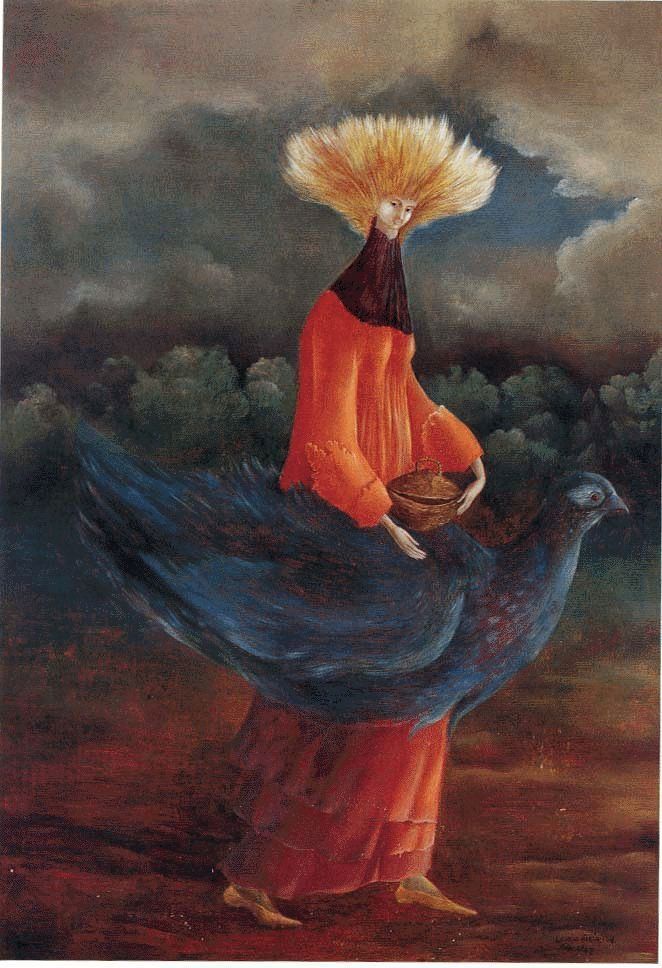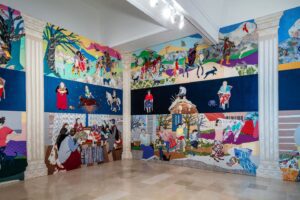
Liviana Martin

Content and images from Ocula Magazine.
Never, as in this 59th Venice Biennale of art, have there been so many artists from all over the world. The Milk of Dreams is the title of the Biennale, taken from the book by the surrealist painter Leonora Carrington. An enigmatic title to suggest current themes: the relationship between man and nature, between man and technology, the metamorphosis of the body, the reuse of materials, in the name of environmental sustainability. Between the two exhibition venues, the Giardini and the Arsenale, the visitor gets lost, so that a choice of the most interesting projects and works, obviously reductive and subjective, is necessary.
Not everything seemed to be at the level of past editions, this is certainly not a dream Biennale, even if the dream recurs frequently in the curators’ intentions as one of the inherent components of the exhibition. But, among the positive aspects, Historical Capsules should be mentioned, a collection of works that forecasts the contemporary artistic trends that are linked to them. The main focus in the Central Pavilion is titled The Witch’s Cradle and presents works by surrealist artists such as Leonora Carrington, Leonor Fini, Carol Rama and others who in their paintings depict a deformed and wonderful world in which human figures are transformed, anticipating the metamorphosis of the body and the relationships between man and nature with some of the artists on display.
The Romanian artist Andrea Ursuta creates posthuman bodies in his sculptures, hybridizations, imagined as new combinations between organic and artificial, premonitions of a dehumanized future.
Fanciful drawings, where human beings are depicted together with human-animal hybrids, mermaids and chimeras, are made by the Inuk artist Shuvinai Ashoona who captures the dramatic changes experienced by the Inuit community in which she lives.
The denunciation of the injustices suffered by indigenous communities due to the most powerful nations is also present in the Nordic Pavilion, dedicated to the theme of forced uprooting perpetrated against the Sami people, inhabitants of Lapland. Sculptures made with natural elements (reindeer skins, earth, vegetable fibers), paintings that, like comics, trace the elements of colonial power, smells linked to Lapland.
The Roma are the protagonists in the Polish pavilion. The author, the artist Malgorzata Mirga-Tas, of Roma ethnicity, wants to highlight the cultural and artistic contribution of her people. She does it in a surprising and refined way: taking a cue from the fifteenth-century frescoes of Palazzo Schifanoia in Ferrara, she creates an installation with patchwork panels to portray the Roma epic, inserting mythological elements and enhancing the work of the women who wove these tapestries.
Simone Leigh, winner of the Golden Lion and the first African American woman to represent the United States, deals with the construction of black female subjectivity. Her beautiful Brick House welcomes visitors to the Arsenale: the monumental bronze bust of a black woman, whose round skirt resembles a clay house, and which was originally located on New York’s High Line, is part of a group of sculptures that blend bodies and architectural references, from the howitzer houses of Chad to the clay and wood buildings typical of Togo. Leigh evokes the idea of a container, a comfortable space, an object of consumption and a sanctuary in relation to the body of the black woman. Her feminist and anti-racist discourse continues inside the United States Pavilion, whose façade, with the installation of a thatched roof, recalls a West African palace from the 1930s: among other sculptures, The Last Garment, a bronze sculpture depicting a laundress at work, washing clothes in a pool of water and refers to postcards of the colonial era that promoted the stereotypes of the ‘good savage’.
For the Swiss Pavilion Latifa Echakhch uses everyday materials, wood recovered from previous biennials, to create large installations. The artist worked on emotions and musicality: as if entering the soundbox of an instrument we enter the Pavilion, where, with flashing lights, we observe assembled figures, similar to carnival parade floats: heads, hands, gigantic but ephemeral busts, made from material that wears out and vanishes quickly.
The war in Ukraine has also, of course, affected the Biennale.
I pass in front of the Russian Pavilion, which in the past years had given us beautiful exhibits; its closure is almost a symbol of the madness of men. Piazza Ukraine, a little further on, is a monument made of sandbags, representing what is done during the war to protect artistic sites from bombing.
The Ukrainian artist Pavlo Makov exhibits the installation The Fountain of Exhaustion, a pyramid of funnels where the water, flowing as it reaches the base, runs dry: it is the extinction of natural resources, but also of culture and politics.

Italian Pavilion curated by Eugenio Viola
Courtesy DGCC – MiC

Italian Pavilion curated by Eugenio Viola
Courtesy DGCC – MiC
The relationship between man and technology develops in the works of female artistic avant-gardes grouped in the capsule The Seduction of the Cyborg. The word cyborg is a word that combines cybernetics and organism: it is not a robot or an android, but a human being integrated with an artificial technology that gives it enhanced capabilities. Artists such as Giannina Censi, Rebecca Horn, Louise Nevelson have imagined women’s bodies as a place where the boundaries between human, animal and machine are more vulnerable, the beginning of a post-thuman and post-gender future.
The contemporary artist Sandra Mujinga, a native of the Republic of Congo, presents four hooded sculptures, consisting of cloaks with human features and long fabric limbs, tentacles and trunks, almost humanoids evolved to adapt to the world to come.
The Venice pavilion represents with elegance and originality the most classic of the myths of metamorphosis, that of the nymph Daphne, who, to escape the desires of the god Apollo, is transformed into a laurel tree. Daphne is represented in the first room by a hyper-realistic sculpture, wrapped in white sheets, while she, undecided about her fate, is immobilized in a timeless dimension. The next room has a laurel tree in the center that has its roots in a pool of water. Finally, the last room is entirely occupied by dark, muddy earth: an allusion to the exploitation of the Venetian lagoon and what man has done to it?
A condemnation of Italian (and Western) industrialized society is present in the Italian Pavilion, where the only artist is Gian Maria Tosatti. The three large installations that follow one another in the vast rooms have the evocative title History of Night and the Destiny of Comets and specifically relate to the failure of the Italian economic boom in the 1960s, even if the discussion can also include economic globalization. Tosatti has collected machinery and objects purchased from failed businesses such as conveyor belts, sewing machines from the last century, now obsolete and outdated. The visitor walks in silence through these large spaces, almost unused sanctuaries and feels crushed by the monstrosity of the machines. At the end, in a cathartic vision, a dark room where water floods the square from which goods should leave, almost the premonition of an imminent disaster. But, in the dark of despair, many small lights continuously turn on and off. The artist leaves us a message of hope, like the fireflies mentioned by Pasolini, one of his favuorite authors. From the darkness of civilization we can get out by relying once again on nature.
Biennale of Art, Venice, the Giardini and Arsenale 23 April- 27 November 2022 ticket 25 euros

